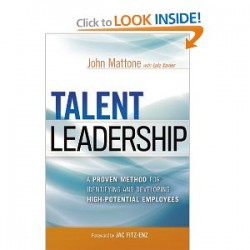Talent Leadership book by John Mattone
“Talent leadership” seems like the most broad category you can possibly imagine. I couldn’t stop the thought from entering my mind; however, less than ten pages into this book I realized that it was not going to be what I expected. This thing is full of highly detailed, hands-on activities that you can use to identify and develop your high potential employees. This is even a succession planning handbook, among other things. The diverse topics under one “umbrella” make “talent leadership” a great title for this book.
 What I liked
What I liked
- The talent leadership book kicks off early with a great quote:Â accurate information drives effective strategies. Want to make the right choices in terms of overall direction/strategy? Make sure you have accurate information (not only with lagging indicators, but with leading indicators).
- A survey by SHRM-the Society for Human Resource Management-points out the #1 problem for organizations today: building a strong pool of successors for each position/level. If you haven’t had a conversation on succession planning within your organization, you’re behind the curve. To be honest I have brought it up a few times, but without a plan for identifying and preparing those candidates, the conversation always moves to the back burner.
- A, B, C players–if you don’t know which one someone is, how do you know if you should invest in them or pass them over for development opportunities? It’s a core talent leadership question that you need to be able to answer. For more on the A/B/C discussion, see my series on the topic (part 1 and part 2).
- The 10 key elements of a strong performance management system: employee involvement, valid performance criteria, year-round process, proper preparation, avoiding stereotypical thinking, input from others, consistency, rating integrity, dialogue, and employee ownership. In my organization I’d say we are doing at least six of those really well. How about you?Â
- In the appendix (page 249 for those following along) there is a phenomenal diagnostic tool for evaluating the health of your succession management program. I’d say step one is to get one in place if you don’t already have one, Â but step two is to continuously evaluate it to make sure it’s producing results. This tool will help you manage that part of the talent leadership puzzle well.
Wrap up
And there you have it. If you’re looking at how you can identify and develop your own high potential employees and set up a strong succession planning system based on facts instead of “Bob looks like he might be a high potential, so let’s pay him more to make him stay with us.” Click here to get your copy.
Click here for other book reviews or to learn about why you need a reading list for leadership.

 Okay, people, I have a short post today. Why? Because I’m stumped. Recently I read this
Okay, people, I have a short post today. Why? Because I’m stumped. Recently I read this